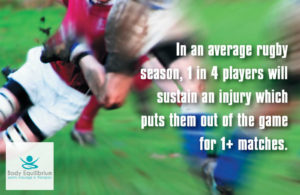
As you probably already know, I work with Long Buckby RFC. I know the 2016-17 season has now (sadly!) drawn to a close for a couple of months but it won’t be long until pre-season training starts, so now is the time to think about getting yourself into optimum fitness, which includes addressing any injuries or physical dysfunctions you may have gained in the past season.
Rugby is a full-contact sport, and therefore makes it a war zone for injury during the course of a match. In an average season, 1 in 4 players will receive an injury which puts them out of the game for 1 or more matches. As the average player performs 20-40 tackles per match and nearly half of all injuries happen during the tackle, it’s easy to see why it’s a key topic among physical therapists and sports massage practitioners.
Which rugby players suffer most with injuries?
According to a three year study of injuries affecting players in the top 14 rugby clubs in France between 2012 and 2015, the front row (2 props and one hooker) account for 26% of the total injuries with the hooker being the worst affected. The player wearing the No 2 shirt suffers more blood, face, neck and knee injuries than any other position, and is second in the list of concussion and shoulder injuries.
After the hooker, the props take their fair share of beatings with the loosehead (No 1 shirt) incurring more shoulder injuries than any other position and the tight-heads (No. 3 shirt) ranking highest in the ankle injury charts. Interestingly, while the loosehead props were second only to the hooker in suffering neck and shoulder injuries, the tightheads suffered less in those categories but more with lower leg injuries.
In fact, the front-row and half-backs made up 43% of all injury substitutions. Fly-halves suffer more concussions than any other position and scrum-halves suffering more shoulder and knee injuries (with the exception of the front-row).
On a positive note, the incidence of concussion didn’t change in the three seasons, with between 36 and 38 concussions per season, an average of two cases each weekend. In addition the number of blood injuries dropped by 22%, and face injuries fell by 27%.
However elbow injuries increased dramatically (133%) and hand injuries soared by 250% over the three seasons.
When are rugby injuries most likely to happen?
According to the research nearly half of all injuries were sustained in tackles (46.6 per cent) and the player being tackled accounted for nearly a third of them. Contrary to popular belief, the scrum only accounted for 2.4 per cent of injuries.
More injuries occur during matches (57%) than in training, and more often in the second half of the game.
What are the most common rugby injuries?
- Over 40% of injuries are muscular strains or contusions (bruising)
- 30% are sprains (sprained ankles represent nearly 1 in 7 rugby injuries)
- Between 5-25% of rugby injuries are head injuries, including concussions (which represent 44% of all head injuries)
- In youths aged 10-18 years, 35% of injuries are fractures, of which 24% involve the clavicle
- Other injuries include cauliflower ears, dislocations, cuts, scratches and friction burns
How can rugby injuries be prevented?
- Make sure to perform a balanced and structured training programme which involves strength, flexibility and endurance, including proprioceptive and neuromuscular training
- Correct technique when tackling, rucking and scrumming is particularly important
- Use a quality, properly fitted mouth guard
- Participate at a level that is consistent with your ability. Injuries happen more frequently between teams and players of unequal ability.
- Adhering to the rules for the formation of the scrum
- Ask your sports massage professional or sports medical professional about any training or injury questions
…and just to finish, some random facts…
- The first ever rugby game took place between Scotland and England (Scotland won!).
- Originally a try had no value but allowed the attacking team to “try” a kick at goal. If successful it converted a try into a goal, hence the name.
- Rugby balls are oval because they used to be made using inflated pig bladders.
- Rugby is the national sport of 3 countries; Wales, Madagascar and New Zealand.
- The whistle used for the opening match at every World Cup is the one used by Welsh referee Gil Evans for an England-New Zealand match in 1905.
- The notion of singing a national anthem before a sporting event originated at a rugby match.
- The current record for the highest scoring game ever is the match between the All Blacks and Japan in the 1995 World Cup (the All Blacks beat Japan 145 to 17).
